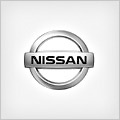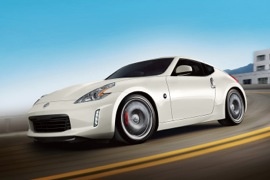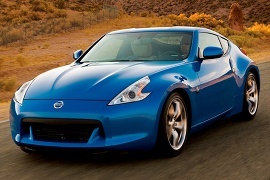
NISSAN 370Z
Generations Timeline, Specs and Pictures

Updated for 2012, the beloved 370Z looked like the modern variant of the 240Z, with its low roofline and the popped out rear fenders.
The 370Z came with 3 versions: the standard coupe, the roadster and the super sporty Nismo.
Driven by a 3.7-liter V6 engine, the 370Z had 332 hp and 270 nM of torque.
The power was sent to the real wheels through a 6-speed manual transmission.
The 370Z was fitted with a small, cozy cabin, that offered great legroom and headroom for the people in the front seats. The dashboard had a simple and clean layout and offered a decent storage space in the center.
The load area was not the best, as the trunk was shaped by the shock towers, thus limiting the available space. The strut bar in the back, although great for rigidity, blocked longer items to be placed in the trunk. Tall objects were also hard to fit in the trunk due to the trunk’s glass lid.
The visibility inside the 370Z was rather poor, the B and C pillars forming a block in the driver’s vision, making it harder in passes.
The cabin was driver-focused, with additional gauges indicating voltage and oil temperature. The driver could adjust the steering wheel and the cluster altogether.
The 370Z ran on 19-inch beautifully designed alloys borrowed from the GTR. Wider tires were used in the back.

The big family of the Z Coupe vehicles from Nissan received a new member in 2008 and it featured a more powerful version than the previous, 2003 model.
Nissan had a long history with the Z models. Before the 370 Z (Z34) it was the 350 (Z33) and 300 ZX (Z32). And the story goes on to 1970 when the first Z was on the market, named Datsun Z240, part of the Nissan brand name. Usually, the new generation of a car is bigger than the one it replaces. Nissan did the opposite, shortening the wheelbase by 100 mm (4”). The overall length was smaller by 70 mm (2.7”) but enlarged the front and rear track and the whole width of the car by 33 mm (1.3”).
Inside the cabin, the driver was the main concern. The 370 Z was a driver’s car. For that reason, a center console separated the driver and passenger seat. The instrument cluster is attached to the steering column and, when that is adjusted, the dials are also moved. Thus, the driver didn’t have to choose between the perfect steering wheel position and the visibility of the gauges.
For the drivetrain, Nissan offered a 3.7-liter V6 engine mated as standard to a 6-speed manual or as an option to a 7-speed automatic transmission with paddle shifters behind the steering wheel. As an industry first, when fitted with the manual, the car “blipped” the throttle to rev-match the engine when downshifting.























































